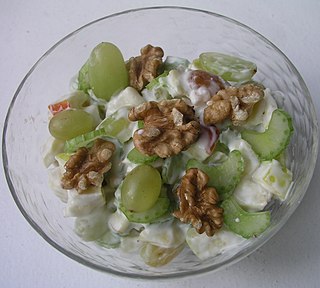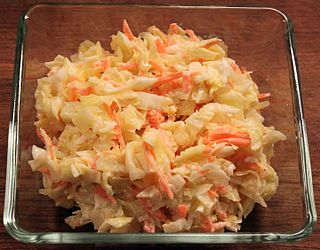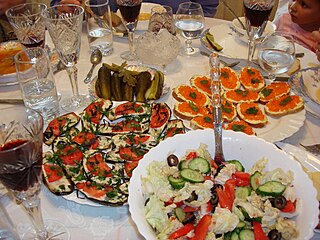
Dill is an annual herb in the celery family Apiaceae. It is native to North Africa, Iran, and the Arabian Peninsula; it is grown widely in Eurasia, where its leaves and seeds are used as a herb or spice for flavouring food.

Cucumber soup is a traditional Polish and Lithuanian soup. It is made from sour, salted cucumbers and potato. Occasionally, rice is substituted for the potatoes.

A Waldorf salad is a fruit and nut salad generally made of celery, fresh apples, walnuts, and grapes, dressed in mayonnaise, and traditionally served on a bed of lettuce as an appetizer or a light meal. The apples, celery, and grapes can all be green, which harmonizes the color palette of the dish.

Tuna salad is a salad dish consisting of tuna and mayonnaise. The tuna used is usually pre-cooked, canned, and packaged in water or oil. Pickles, celery, relish, and onion are popular ingredients to add. Tuna salad is also regularly served by itself, or on top of crackers, lettuce, tomato, or avocado. Chopped boiled eggs may be added.

Polish cuisine is a style of food preparation originating in and widely popular in Poland. Due to Poland's history, Polish cuisine has evolved over the centuries to be very eclectic, and shares many similarities with other national cuisines. Polish cooking in other cultures is often referred to as à la polonaise.

Baba ghanoush, also spelled baba ganoush or baba ghanouj, is a Levantine appetizer consisting of finely chopped roasted eggplant, olive oil, lemon juice, various seasonings, and tahini. The eggplant is traditionally baked or broiled over an open flame before peeling, so that the pulp is soft and has a smoky taste. It is a typical meze ('starter') of the regional cuisine, often served as a side to a main meal and as a dip for pita bread.

Green papaya salad is a spicy salad made from shredded unripe papaya. It is generally believed to have been created by the Lao people and is considered one of the national dishes of Laos. Green papaya salad is also popular in neighbouring Thailand's Isan region, whose population is mainly composed of ethnic Lao and from where it spread to the rest of Thailand. Green papaya salad has also spread to the rest of the continental Southeast Asia, as well as Xishuangbanna (China).

Coleslaw, also known as cole slaw or simply as slaw, is a side dish consisting primarily of finely shredded raw cabbage with a salad dressing or condiment, commonly either vinaigrette or mayonnaise. This dish originated in the Netherlands in the 18th century. Coleslaw prepared with vinaigrette may benefit from the long lifespan granted by pickling.

Tabbouleh, also transcribed tabouleh, tabbouli, tabouli, or taboulah, is a Levantine salad made mostly of finely chopped parsley, with tomatoes, mint, onion, soaked uncooked bulgur, and seasoned with olive oil, lemon juice, salt and sweet pepper. Some variations add lettuce, or use semolina instead of bulgur.

The milanesa is a variation of the Lombard veal Milanese, or the Austrian Wiener schnitzel, where generic types of breaded cutlet preparations are known as a milanesa.

Deviled eggs, also known as stuffed eggs, curried eggs or dressed eggs, are hard-boiled eggs that have been peeled, cut in half, and filled with the yolk, mixed with other ingredients such as mayonnaise and mustard. They are generally served cold as a side dish, appetizer or a main course during gatherings or parties. The dish's origin can be seen in recipes for boiled, seasoned eggs as far back as ancient Rome, where they were traditionally served as a first course. The dish is popular in Europe, North America and Australia.

Levantine cuisine is the traditional cuisine of the Levant, in the sense of the rough area of former Ottoman Syria. The cuisine has similarities with Egyptian cuisine, North African cuisine and Ottoman cuisine. It is particularly known for its meze spreads of hot and cold dishes, most notably among them ful medames, hummus, tabbouleh and baba ghanoush, accompanied by bread.

Bean salad is a common salad composed of various cooked beans—typically green, wax, kidney, and/or lima beans—tossed in a sweet-sour vinaigrette. Variant ingredients include fresh raw onions, bell pepper, and/or other cooked or raw vegetables, such as chickpeas.

Vorschmack or forshmak is an originally East European dish made of salty minced fish or meat. Different variants of this dish are especially common in Ashkenazi Jewish and Finnish cuisine. Some varieties are also known in Ukrainian, Polish and Russian cuisine.
Lunch is a meal eaten around the middle of the day. It is commonly the second meal of the day, after breakfast, and varies in size by culture and region.

Zakuski is an assortment of cold hors d'oeuvres, entrées and snacks in food culture in Slavic-speaking countries. It is served as a course on its own or "intended to follow each shot of vodka or another alcoholic drink". The word literally means 'something to bite after'. It probably originated and was influenced through the fusion of Slavic, Viking-Nordic and Oriental cultures in early Rus' regions like the Novgorod Republic.

Dressed herring, colloquially known as herring under a fur coat or furry herring, is a layered salad composed of diced spekesild covered with layers of grated boiled eggs, vegetables, chopped onions, and mayonnaise. Some variations of this dish include a layer of fresh grated apple while some do not.

Olivier salad is a traditional salad dish of Russian cuisine. Its creation is generally attributed to Lucien Olivier.

















